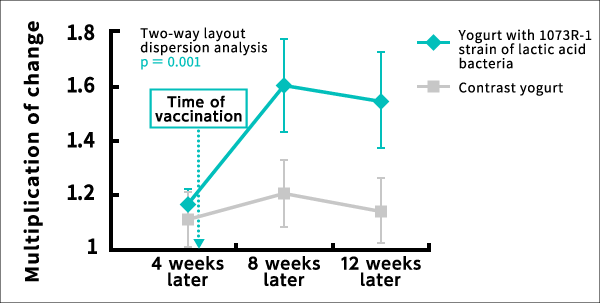|
Top page > Forefront of lactic acid bacteria research > Information on 1073R-1 lactic acid bacteria > Findings from 1073R-1 lactic acid bacteria research(5)
Findings from 1073R-1 lactic acid bacteria research(5)Research suggests that consumption of yogurt containing 1073R-1 lactic acid bacteria could potentially prevent influenza among the elderly.This placebo-controlled double-blind parallel-group comparison study*1, organized by a team led by Professor Keiichi Tsukinoki, Division of Environmental Pathology, Department of Oral Science, Kanagawa Dental University, was conducted at two special nursing homes for the elderly in Kanagawa Prefecture from October through December 2014. It involved a subject pool consisting of 96 seniors living in the homes. A half of the subjects were fed 100 g of yogurt containing 1073R-1 lactic acid bacteria once per day, while the other half were fed placebo yogurt in the same amount and with the same frequency, every day during the 12-week period. Then, the change in the amount of IgA*2 found in their saliva that reacts to influenza A virus subtype H3N2 was measured and compared between the two groups. The subjects in both groups were administered influenza vaccines in early November, roughly five weeks after starting the study. In-saliva IgA that reacts to influenza A virus subtype H3N2 increased (higher rate of change)
The group that was fed yogurt containing 1073R-1 lactic acid bacteria had a significantly larger amount of IgA that would react with influenza A virus subtype H3N2, compared to the control group. In other words, the study confirmed that the subjects in the experimental group not only had an increased amount of IgA in them but also that the increased IgA had the capacity to respond to the influenza virus.
|




